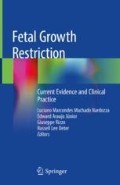Abstract
Although fetal growth restriction (FGR) is considered as the most common and complex problem of modern obstetrics, its prediction is still very low. FGR prediction can be performed in all trimesters, and since it is a multifactorial pathology, prediction must consider several components, such as clinical, biophysical, biochemical, and ultrasound findings. Studies have shown that combined markers, such as clinical features, ultrasound measures, uterine artery Doppler, and biochemical markers, used in algorithms can improve prediction. FGR can be classified as early or late, and studies in the literature show different prediction sensitivities for each category. The main predictors for early FGR were African ancestry, chronic hypertension, prior pregnancy affected with FGR, mean blood pressure, uterine artery pulsatility index (PI), PlGF, and sFlt-1 with a detection rate of 71.4%. For late FGR, the markers were chronic hypertension, autoimmune disease, prior pregnancy affected with FGR, smoking, nulliparity, mean arterial pressure, uterine artery PI, PlGF, and sFlt-1 with a detection rate of 63.5%. FGR screening remains a challenge, and numerous studies are being conducted with an aim of improving its sensitivity. Effective screening helps to identify patients at risk, who would then be monitored more frequently in an attempt to minimize adverse perinatal effects.
Access this chapter
Tax calculation will be finalised at checkout
Purchases are for personal use only
References
Albu A, Anca A, Horhoianu V, Horhoianu I. Predictive factors for intrauterine growth restriction. J Med Life. 2014;7:165–71.
Gardosi J, Madurasinghe V, Williams M, Malik A, Francis A. Maternal and fetal risk factors for stillbirth. Obstet Gynecol Surv. 2013;68:329–31.
Gardosi J, Giddings S, Clifford S, Wood L, Francis A. Association between reduced stillbirth rates in England and regional uptake of accreditation training in customised fetal growth assessment. BMJ Open. 2013;3:e003942.
Roberge S, Nicolaides K, Demers S, Hyett J, Chaillet N, Bujold E. The role of aspirin dose on the prevention of preeclampsia and fetal growth restriction: systematic review and meta-analysis. Am J Obstet Gynecol. 2017;216:110–120.e6.
Tan MY, Poon LC, Rolnik DL, Syngelaki A, de Paco Matallana C, Akolekar R, et al. Prediction and prevention of small-for-gestational-age neonates: evidence from SPREE and ASPRE. Ultrasound Obstet Gynecol. 2018;52:52–9.
Crovetto F, Triunfo S, Crispi F, Rodriguez-Sureda V, Dominguez C, Figueras F, et al. Differential performance of first-trimester screening in predicting small-for-gestational-age neonate or fetal growth restriction. Ultrasound Obstet Gynecol. 2017;49:349–56.
Poon LC, Syngelaki A, Akolekar R, Lai J, Nicolaides KH. Combined screening for preeclampsia and small for gestational age at 11–13 weeks. Fetal Diagn Ther. 2013;33:16–27.
Crovetto F, Triunfo S, Crispi F, Rodriguez-Sureda V, Roma E, Dominguez C, et al. First-trimester screening with specific algorithms for early- and late-onset fetal growth restriction. Ultrasound Obstet Gynecol. 2016;48:340–8.
Poljak B, Agarwal U, Jackson R, Alfirevic Z, Sharp A. Diagnostic accuracy of individual antenatal tools for prediction of small-for-gestational age at birth. Ultrasound Obstet Gynecol. 2017;49:493–9.
Papageorghiou AT, Yu CK, Cicero S, Bower S, Nicolaides KH. Second-trimester uterine artery Doppler screening in unselected populations: a review. J Mater Fetal Neonatal Med. 2002;12:78–88.
Gómez O, Figueras F, Fernández S, Bennasar M, Martínez JM, Puerto B, et al. Reference ranges for uterine artery mean pulsatility index at 11–41 weeks of gestation. Ultrasound Obstet Gynecol. 2008;32:128–32.
Crovetto F, Figueras F, Triunfo S, Crispi F, Rodriguez-Sureda V, Dominguez C, et al. First trimester screening for early and late preeclampsia based on maternal characteristics, biophysical parameters, and angiogenic factors. Prenat Diagn. 2015;35:183–91.
Valiño N, Giunta G, Gallo DM, Akolekar R, Nicolaides KH. Biophysical and biochemical markers at 30–34 weeks’ gestation in the prediction of adverse perinatal outcome. Ultrasound Obstet Gynecol. 2016;47:194–202.
Valiño N, Giunta G, Gallo DM, Akolekar R, Nicolaides KH. Biophysical and biochemical markers at 35–37 weeks’ gestation in the prediction of adverse perinatal outcome. Ultrasound Obstet Gynecol. 2016;47:203–9.
Benton SJ, McCowan LM, Heazell AE, Grysnpan D, Hutcheon JA, Senger C, et al. Placental growth factor as a marker of fetal growth restriction caused by placental dysfunction. Placenta. 2016;42:1–8.
Karagiannis G, Akolekar R, Sarquis R, Wright D, Nicolaides KH. Prediction of small-for-gestation neonates from biophysical and biochemical markers at 11–13 weeks. Fetal Diagn Ther. 2011;29:148–54.
Familiari A, Bhide A, Morlando M, Scala C, Khalil A, Thilaganathan B. Mid-pregnancy fetal biometry, uterine artery Doppler indices and maternal demographic characteristics: role in prediction of small-for-gestational-age birth. Acta Obstet Gynecol Scand. 2016;95:238–44.
Poon LC, Lesmes C, Gallo DM, Akolekar R, Nicolaides KH. Prediction of small-for-gestational-age neonates: screening by biophysical and biochemical markers at 19–24 weeks. Ultrasound Obstet Gynecol. 2015;46:437–45.
Basuki TR, Caradeux J, Eixarch E, Gratacós E, Figueras F. Longitudinal assessment of abdominal circumference versus estimated fetal weight in the detection of late fetal growth restriction. Fetal Diagn Ther. 2018; https://doi.org/10.1159/000485889.
Miranda J, Triunfo S, Rodriguez-Lopez M, Sairanen M, Kouru H, Parra-Saavedra M, et al. Performance of third-trimester combined screening model for prediction of adverse perinatal outcome. Ultrasound Obstet Gynecol. 2017;50:353–60.
Bakalis S, Peeva G, Gonzalez R, Poon LC, Nicolaides KH. Prediction of small-for-gestational-age neonates: screening by biophysical and biochemical markers at 30–34 weeks. Ultrasound Obstet Gynecol. 2015;46:446–51.
Farina A. Systematic review on first trimester three-dimensional placental volumetry predicting small for gestational age infants. Prenat Diagn. 2016;36:135–41.
Guiot C, Gaglioti P, Oberto M, Piccoli E, Rosato R, Todros T. Is three-dimensional power Doppler ultrasound useful in the assessment of placental perfusion in normal and growth-restricted pregnancies? Ultrasound Obstet Gynecol. 2008;31:171–6.
Author information
Authors and Affiliations
Corresponding author
Editor information
Editors and Affiliations
Rights and permissions
Copyright information
© 2019 Springer Nature Switzerland AG
About this chapter
Cite this chapter
Zamarian, A.C.P., de Jesus Cruz, J., Nardozza, L.M.M. (2019). Prediction. In: Nardozza, L., Araujo Júnior, E., Rizzo, G., Deter, R. (eds) Fetal Growth Restriction. Springer, Cham. https://doi.org/10.1007/978-3-030-00051-6_6
Download citation
DOI: https://doi.org/10.1007/978-3-030-00051-6_6
Published:
Publisher Name: Springer, Cham
Print ISBN: 978-3-030-00050-9
Online ISBN: 978-3-030-00051-6
eBook Packages: MedicineMedicine (R0)

